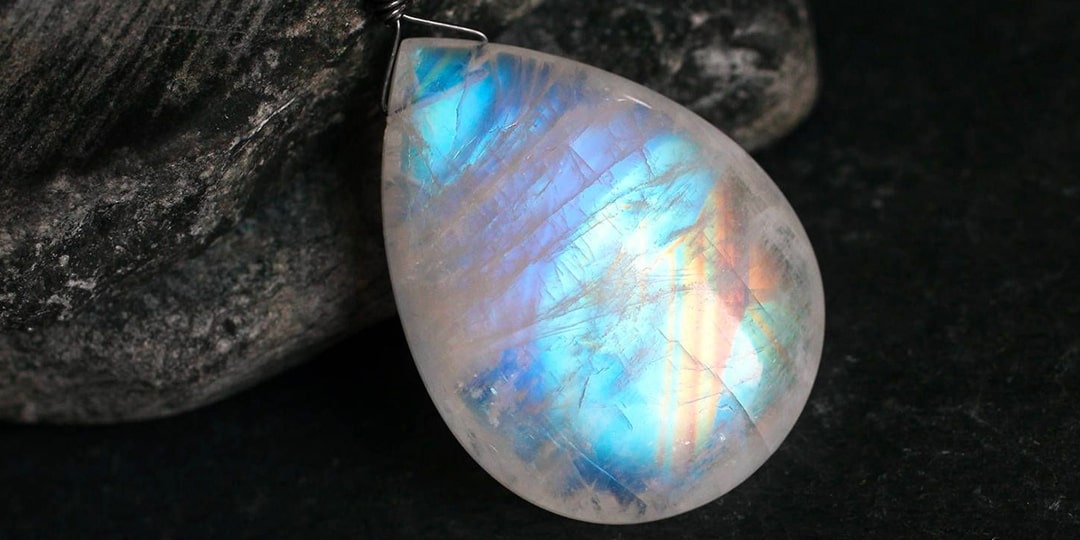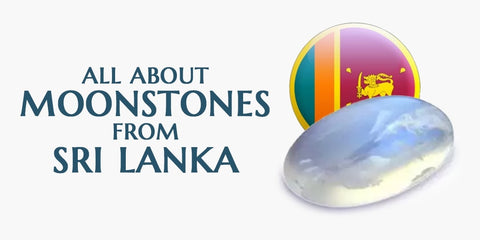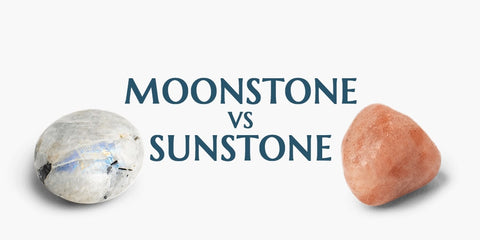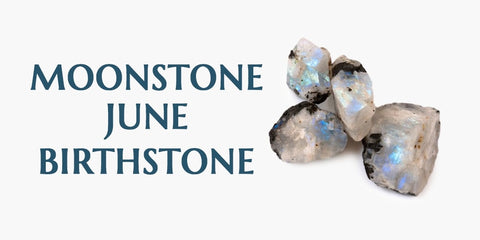
Moonstone Meaning
Stone of spirituality and travelers, Moonstone intrigues by its name but also its many virtues. Its vitreous and pearly brilliance earned it in the past the nickname of fish eye. Discover the meaning of moonstone, its origin and all its benefits.
List of benefits and significance of Moonstone
- Relieves menstrual disorders and pain
- Promotes better sleep
- Calms hyperactivity in children
- Helps to heal skin problems
- Develops intuition and creativity
- Helps to activate a good digestion
- Strengthens fertility and protects pregnancies
Benefits of moonstone

Moonstones have many spiritual and physical benefits.
Moonstone, a sparkling white color with blue highlights, is particularly popular with women as a stone of great power. This mineral enhances perception and intuition and releases tension. Moonstone gives a youthful glow and ignites the joy of living. Let's see it in detail.
Emotional and spiritual benefits
The moonstone is a benevolent and positive stone. It harmonizes the different energies, emotions and allows to reach a state of quietude and inner peace. It is a stone that strengthens couples and the love that two people have for each other. With its soft energies it calms disputes and promotes good understanding.
The translucent mineral develops sensitivity, creativity, imagination and gentleness. It also strengthens extra-sensory abilities such as intuition, clairvoyance and facilitates the distinction between sincere and false people. This gemstone represents Yin, a pure, gentle and feminine energy. It favors open-mindedness, tolerance and kindness of soul. It helps not to fear the one who does not look like us.
In men, the moonstone calms the temperaments too warlike, quarrelsome or too impulsive. It favors the feminine sensibility and thus helps to understand better the woman.
Physical benefits
In crystal healing, one property of moonstone is to regulate the nervous system and the production of hormones. It decreases the secretion of cortisol, the stress hormone, and promotes the production of dopamine, the well-being hormone. For women, moonstone has the power to regulate cycles and avoid pain during menstruation.
With its soothing and anti-stress effects, the gem harmonizes the digestive system and thus promotes good digestion and transit. A massage with polished moonstones helps to restore the skin's radiance and fights against pimples and skin diseases.
Different types of moonstone

There are several types of moonstone, including black ones.
The moonstone exists in several varieties, we find :
- The real moonstone : It is white in color with bluish shades. Scientists call it Peristerite;
- The moonstone known as "rainbow" : It is a variety of labradorite of white color;
- Sri Lankan moonstone : This stone, with its greenish color and pearly reflections is impressive;
- The moonstone known as "peach" : This variety is distinguished by its brown and orange color;
- The larkavite moonstone : Also called black moonstone;
It is also possible to find opalines marketed under the name of moonstone. Indeed, opalines belong to the same family of this mineral.
The composition of the moonstone

The moonstone is made of multiple rocks.
Generally speaking, moonstone is found in alkaline and plutonic rocks, metamorphic rocks and hydrothermal veins. Geographically, deposits are found all over the world. In Africa, it is found in Tanzania and Madagascar, in the American continent the deposits are in the USA and Brazil. As for Europe, you will find them in Poland, Norway and in the Swiss Alps. In short, regarding its composition, it must be said that it belongs to the family of feldspars and the group of silicates.
Moonstone is a variety of orthoclase which, being in the form of pure crystals, takes the name of adularia. The name orthoclase was given to this mineral by the famous René-Just Haüy. Because in Greek, the term ''orthose'' means ''right''. As for the chemical formula of the orthosis, this one is K (AISi3 O8). Its density is between 2.53 and 2.6 and its hardness is rated from 6 to 6.5 on the Mohs scale. Normally, moonstone is colorless. However, it can be white or with shades of yellow.
Origin of the name moonstone
Ancient civilizations named natural stones in simple ways, often based on their colors or physical characteristics. The name moonstone comes from its soft color and its pearly reflections similar to the lunar star. Its resemblance is such that in ancient times it was thought to be a fragment of the moon.
In reality the name moonstone is the commercial name that we all know. But the strictly scientific name of the stone is Adular in reference to Mount Adula located on the border between Switzerland and Italy which was home to a huge moonstone deposit towards the end of the 18th century. But today this deposit is unfortunately exhausted. Moonstone can sometimes be found under the name Hecatolite in reference to Hecate, goddess of the moon.
Moonstone in ancient civilizations
The moonstone occupies an important place in many civilizations. Our ancestors have always been fascinated by the stars, in particular the Sun and the Moon, to which they associated a celestial power. Indeed, the lunar cycles influence the environment, the Earth, the sea, but also the behavior of humans. They modify the mood, sometimes the sleep. The pale stone directly connected to the Moon has therefore a very strong symbolism. If you want to know more about the origins of this gemstone, see our article dedicated to the history of moonstone.
Natural moonstone is a variety of orthoclase with soft shades of white and pearly reflections. As with labradorite, it is the phenomenon of adularescence that gives moonstone its characteristic reflections. In ancient times, the Greeks worshipped the stone hecatolite that they associated with the goddess Hecate. With offerings, they hoped to receive protection and the power of clairvoyance.
Some people, like the Indians, thought that the moonstone was actually born from a stone that had stored a lot of lunar rays. Others believed that it was a fragment of the moon that had fallen to earth. Even today this pearly white stone is considered sacred in India. Among the Romans, the moonstone was associated with femininity and clairvoyance. They also believed the stone had the power to change friendly feelings into love and to strengthen couples.
In the Middle Ages, the clear lunar mineral was worshipped by women, as moonstone was linked to fertility and passion. It increased fertility and improved the chances of getting pregnant. In addition, it had the power to protect the woman and the fetus during pregnancy. In Egypt, people who had to travel at night wore moonstone pendants to protect themselves from attacks and evil spirits.
Much later, in the early 2000's, moonstone became one of the emblems of Florida in honor of the Kennedy Space Center that sent the first men to the moon in 1969. Today, the mineral with its sumptuous pearly white reflections is mainly used in jewelry to make moonstone bracelets, rings or pendants. It is also very appreciated in crystal healing for its powerful benefits.
The color of moonstone

Moonstones are known for their blue and rainbow colors, but there are many others.
The colors of moonstones are therefore very varied and depend on their place of extraction. However, their chemical composition remains more or less the same, which would explain why all these moonstones have more or less the same properties and virtues. It is in particular a stone known for its familiarity with the feminine concept and all the communicative, social or emotional qualities associated with it.
The color of the moonstone would thus have essentially an aesthetic vocation, which would allow each one to be directed towards a nuance which corresponds best to its desires. Nevertheless, some claim that even the color would have an impact on the properties of each stone. The famous black moonstone, quite rare, would be more oriented towards the development of psychic and spiritual capacities of high flight, which would explain the strong interest that it arouses.
Moonstones have a wide range of basic colors. In addition to white or colorless moonstone, we can also find yellow moonstone, gray moonstone, brown moonstone, blue moonstone, green moonstone, iridescent moonstone, pink moonstone and black moonstone.
The moonlight effect
Moonstone crystals owe their name to their special moonlight-like glow, i.e. a white, silver, blue or rainbow glow on the surface. This is because the layered cryptocrystals of the two feldspars intersect in parallel but have slightly different refractive indices, so they scatter visible light, sometimes with interference or diffraction; therefore, the combined effect of the feldspars on light produces the unique glows on the surface of moonstone.
As one of the most valuable and popular stones on earth, moonstone is soft and pure, with a beautiful glow reminiscent of the bright moon. Its beauty and significance is what makes it so appealing.
Why wear moonstone jewelry?

Moonstone jewelry is the best way to enjoy the benefits of this ancient stone.
Each moonstone has its own story and this is what makes it unique. Whether mounted as a necklace, pendant, bracelet, ring or even earrings, moonstone will bring out and develop that feminine aura that envelops you and characterizes you.
Luminous and crystalline, the moonstone has the advantage of being easily matched with all other colors. Dare to be daring and wear a moonstone jewel around your neck, on your wrist, on your finger or in your ears!
By the way, when you think about it... Is it you who chose the moonstone or is it the one that subconsciously attracted your interest? The energies that moonstone gives off and the virtues that are attributed to it highlight and reveal the strength of your deepest qualities: gentleness, sensitivity, sensuality, creativity, tolerance...
It is precisely because its virtues and your qualities match and complement each other that no one will be able to wear the moonstone as you will. It is because you are unique that you deserve a stone that is also unique!
Chakra and moonstone use
Considered for thousands of years as magical and mysterious with its ghostly luminescence, moonstone is able to bring protection and good luck to travelers. Bringing a deep connection with intuition, moonstone corresponds to the second chakra. This is the Sacral Chakra or Svâdhistâna-Chakra located below the navel. This is why the moonstone is associated with emotions and sexual energies.
To overcome fertility problems and to fight against sterility, it is recommended to place this stone at the level of the ovaries for about fifteen minutes a day. For people who suffer from thyroid problems or ocular migraines, it is recommended to wear moonstone jewelry.
Care of moonstone
Avoid acids and alkalis : Moonstone jewelry should not be washed with acidic or alkaline liquids; therefore, all cosmetics, perfumes, oil stains, etc. should be kept away. Beware of rubbing: Moonstones have a hardness of 6-6.5, which is a relatively soft material compared to other gems. Therefore, it is necessary to avoid friction and collision with hard materials to avoid scratches.
Do not collide : Moonstones have two sets of complete cleavage inside, which can be easily broken by external forces. The beauty is fragile and must be protected with care.
Conclusion
Today, moonstone is an incredibly popular piece of jewelry. Having experienced a revival in the late 20th century as a fashion piece, it remains popular as a beautiful and unique piece. It can be used in a wide variety of jewelry, from earrings to pendants.






